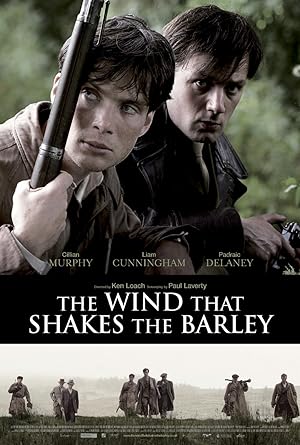When you know little to nothing about Irish history and watch movies about Irish history, it can be hard to figure out what time period the movie is set in and usually the conflict is quite clear cut, Irish versus British. The Wind That Shakes the Barley is an amazing movie about the Irish War of Independence to the Irish Civil War and would be perfect viewing immediately after Michael Collins or even The Hunger Games franchise. Who needs The Stanford Prison Experiment when you have The Wind That Shakes the Barley?
The Wind That Shakes the Barley is predominantly an ensemble cast about how a local village in Ireland is affected by these large historical events. The Wind That Shakes the Barley’s narrative can be applied to every revolutionary moment. Initially things seem very black and white. The British are depicted as evil. The British are people who kill underage, unarmed boys with toys for not being appropriately deferential, abuse women and harass working men just doing their job. The village literally never has a moment when they can just breathe without being physically and verbally assaulted. These actions radicalize the locals, who join the Irish Republican Army.
As the doctor, played by Cillian Murphy, who had an opportunity to leave the conflict, but is conscience bound to his homeland, becomes more ensconced in the revolution, he sees the IRA’s flaws, including the execution of young men/children who are forced to betray the IRA, but are obviously coerced, not enthusiastic, about the betrayal. Some locals just want to change power with the British, but would be guilty of the same sexist or economic exploitation that they accuse the occupying forces of doing and violate the principles of democratic government earlier espoused.
When a compromise is struck between the IRA and the British, the conflict among the IRA has some IRA members in power acting more like the British while some IRA members agitate for further revolution. Now it is Irish on Irish crime, and the Catholic Church sides with those in power whereas before they would be seen in the trenches with the revolutionaries when it was against the British. The IRA establishment becomes seen as worse than the British because they are killing their brothers and aren’t an occupying force.
The Wind That Shakes the Barley stars Murphy, who is alternatively very relatable and dreamy to look at or in close ups of his cold steel blue eyes, terrifying and determined. Even though The Wind That Shakes the Barley primarily sees events through his eyes, he does not always dominate the focus of each scene, and it is not until the denouement where we get to see his terrifying side. The Wind That Shakes the Barley also features Liam Cunningham, whom I have never seen give a bad performance and is well known for his role in Game of Thrones as Cer Davos.
The Wind That Shakes the Barley is verdantly shot and feels real as opposed to shot with sepia-toned, preserved in amber respect. If you decide to watch it and you’re not used to the Gaellic accented English, put on the subtitles immediately. The Wind That Shakes the Barley should be required viewing so you don’t get lulled into politics of demonization of the other side.
Stay In The Know
Join my mailing list to get updates about recent reviews, upcoming speaking engagements, and film news.





